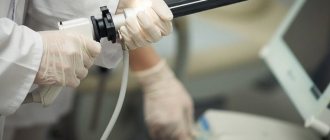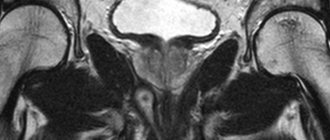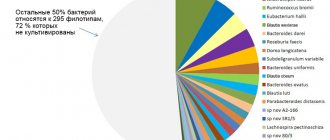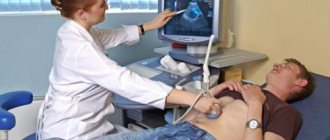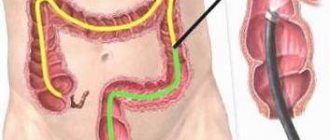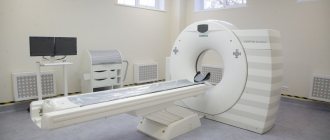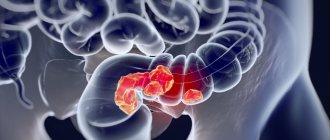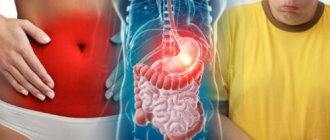Sigmoidoscopy is a technique for examining the intestines using endoscopic equipment (a sigmoidoscope connected to a video camera and a computer monitor). Sigmoidoscopy is easier to tolerate by the patient than colonoscopy, and is a much more informative technique than sigmoidoscopy - it allows you to detect up to 90% of pathological processes that occur in the rectum: infectious lesions, fissures, stenosis of various origins (narrowing of blood vessels), prolapse of hemorrhoidal fissures and etc.
Who is indicated for sigmoidoscopy?
Intestinal examination using a sigmoidoscope is prescribed for patients who have:
- cholecystitis (inflammation of the gallbladder) in chronic form;
- stones in the gall bladder or bile ducts;
- a number of gynecological and andrological diseases;
- dysbacteriosis;
- inflammation of the colon;
- rectal tumors;
- irregular bowel movements;
- bleeding from the rectum;
- space-occupying formations of the uterus and appendages, endometriosis;
- significant enlargement of the prostate.
Services
Sigmoidoscopy – diagnosis of the mucous membrane of the rectum and sigmoid colon using a sigmoidoscope. The procedure allows you to determine the presence of inflammation of the mucous membrane, polyps, foreign bodies, diverticula, tumors, hemorrhoids and fissures in the intestines.
The examination is carried out using a thin, flexible, soft hose 50 cm long, equipped with a video camera at the end. The image of the walls of the rectum and sigmoid colon is transmitted to the monitor screen on an enlarged scale and with excellent resolution (HD) in real time.
Sigmoidoscopy is prescribed by a proctologist if there are medical indications to confirm the diagnosis.
During sigmoidoscopy, the endoscopist may:
- biopsy - removal of a piece of tissue for histological examination for malignancy
SYMPTOMS FOR WHICH RECTAL DIAGNOSIS IS PRESCRIPTED
- bowel disorders - alternating diarrhea and constipation, fecal incontinence
- symptoms of intestinal dysbiosis - abdominal pain, bloating, stool disorders, bad breath, attacks of indigestion and nausea after meals
- bloody discharge from the rectum during or after bowel movements
- the presence of tumors and inflammation of the uterus and appendages in women, endometriosis
- prostate enlargement in men
INDICATIONS FOR SIGMOSCOPE
- painful symptoms mentioned above
- patients with colitis, chronic cholecystitis
- suspicion of colon cancer - iron deficiency, causeless weight loss, loss of appetite, constant high body temperature, bowel dysfunction and other symptoms of dysbiosis
- postoperative observation, after cholecystectomy in the period of 3-7 years after surgery
PREPARATION FOR RECTAL DIAGNOSIS
Good cleansing of the intestines from feces, food debris on the intestinal walls and adherence to a slag-free diet are the keys to a successful examination.
1-2 days before the procedure, limit the consumption and combination of foods that cause gas, constipation or any symptoms of indigestion. These are fresh vegetables and fruits, herbs, cereals, legumes, mushrooms, berries, black bread, dairy products, sauces, spices, herbs, carbonated drinks.
You can consume broth, boiled meat, fish, chicken, cheese, butter, juice without pulp, tea, water, non-alcoholic non-carbonated, uncolored drinks.
On the eve of the examination, cleanse the intestines using laxatives:
Option 1. Taking Fortrans
On the eve of the study, the last meal should be no later than 16.00. On the eve of the examination, dissolve 4 sachets of Fortrans in 4 liters of boiled water, and 1-2 hours after the last meal, drink the resulting solution, 1 liter per 1-1.5 hours. In case of severe nausea, you can drink the solution with juice without pulp.
If you are booked for the procedure after 13.00, take 2-3 liters the evening before the examination and 1-2 liters in the morning on the day of the examination (4 liters in total). You need to stop taking Fortrans 3-4 hours before the procedure. A two-stage intake of Fortrans (evening + morning) promotes better preparation and is easier to tolerate.
Option 2. Taking Moviprep
Dilute the contents of one sachet (sachet) A and one sachet B in a small amount of water until completely dissolved. Adding water, bring the volume to 1 liter. Mix well. Accepted according to the scheme depending on the time of the procedure:
8.00 – 10.00. The day before video sigmoidoscopy: drink only approved liquids for lunch and dinner. At 19.00 - 20.00, take the first liter of the drug solution. At 21.00 - 22.00, take the second liter of the drug solution. After each liter of the drug taken, you must drink 500 ml of the approved liquid.
10.00 – 14.00. The day before video sigmoidoscopy: breakfast and light lunch until 13.00 according to the list of permitted foods; dinner: only permitted clear liquids. At 20.00 – 21.00, take the first liter of the drug solution. Day of examination: at 6.00 – 7.00, take the second liter of the drug solution. After each liter of the drug taken, you must drink 500 ml of the approved liquid.
14.00 – 19.00. The day before the procedure: last meal at 18.00 (light dinner). Day of sigmoidoscopy: in the morning: only permitted clear liquids. At 8.00 – 09.00 take the first liter of the drug solution, at 10.00 – 11.00 take the second liter of the drug solution. After each liter of the drug taken, you must drink 500 ml of the approved liquid.
If you need to take important medications every day (heart, against high blood pressure, etc.), you can take them
HOW IS SIGMOSCOPY PERFORMED?
- the patient lies on his left side, with his legs bent
- the doctor gradually inserts a sigmoidoscope through the anus into the rectum to a depth of 50 cm, studying the mucous membrane from the images on the monitor
- Some patients have the urge to defecate as a natural reflex. To do this, the endoscopist asks you to perform breathing exercises (inhale-exhale) during the procedure
- after sigmoidoscopy, short-term painful sensations and blood discharge from the rectum are possible
The duration of sigmoidoscopy is 60 minutes.
In what other cases is sigmoidoscopy performed?
- the presence of polyps (abnormal growth of tissue above the mucous membrane) of the gastrointestinal tract;
- to monitor the effectiveness of therapy for a number of intestinal diseases;
- after cholecystectomy (removal of the gallbladder);
- when preparing a patient for any transrectal (through the rectum) methods of treating the prostate;
- as a method of collecting material for further research;
- for extracting foreign objects;
- In elderly patients, sigmoidoscopy is performed as a screening for the prevention of intestinal cancer.
History and examination by a proctologist
Before conducting the study, the doctor must take a history of the disease. To do this, you need to know the age of the patient who presented with the problem of bleeding from the anus. If bleeding occurs in a young patient or child, it may be Meckel's diverticulum. If bleeding occurs in an adult patient, this may indicate the presence of diverticulosis or angiodysplasia. However, these diseases are not accompanied by pain in the abdomen or rectum.
If the patient has already undergone a course of radiation therapy, then we can make the assumption that the blood appeared as a result of radiation colitis or proctitis. Ischemic colitis often makes itself felt with sharp pain in the lower abdomen. Infectious and ulcerative colitis is accompanied by symptoms such as high temperature, fever, abdominal pain and indigestion. Often, minor rectal bleeding may occur during bowel movements due to small cracks.
If the patient complains of frequent constipation, diarrhea and irregular bowel movements, it is necessary to check the intestines for the presence of cancer.
It is imperative to conduct a digital examination of the anus, as a result of which hemorrhoids or anal fissure may be detected, which also often lead to minor bleeding. However, you cannot limit yourself to just one inspection. You should definitely undergo an examination by a coloproctologist, who can prescribe a sigmoidoscopy of the intestine in Moscow.
Contraindications
In some cases, the patient is prescribed alternative methods of intestinal examination.
Contraindications to sigmoidoscopy are divided into:
Strict:
- agony;
- myocardial infarction;
- pulmonary and heart failure.
Relative:
- the patient has recently (less than six months) suffered a heart attack or stroke;
- there have been episodes of cardiac arrhythmia in the patient;
- adhesions in the abdominal cavity;
- early postoperative period (up to a week);
- the patient experiences epileptic seizures;
- he experiences acute pain in the anus and rectum;
- suffers from coagulopathy (blood clotting disorders);
- The patient has large hernias.
If there are absolute contraindications, sigmoidoscopy is refused. Relative ones, as a rule, are not the reason for canceling the procedure, but require special caution in the actions of the doctor.
Diagnostic capabilities and research features
In most cases, sigmoidoscopy is performed to obtain information about the condition of the intestinal walls and mucosa. Using this endoscopic method, doctors identify:
- polyps and other neoplasms;
- cracks;
- diverticula;
- proctocolitis;
- sources of rectal bleeding;
- infectious lesions;
- stenosis (narrowing of the intestinal lumen).
If it is necessary to obtain samples of affected tissue during sigmoidoscopy, a biopsy can be performed. It is possible to combine the examination with treatment procedures (for example, removal of polyps).
How does the procedure work?
Sigmoidoscopy is not a complex procedure. It takes about 15 minutes and does not cause pain in the patient; it is performed without anesthesia. However, if necessary, anesthesia may be used.
The patient lies on his left side, and the doctor performs a digital rectal examination of the rectum. Men undergo, among other things, a thorough examination of the prostate to detect the presence of cancer. Then a sigmoidoscope is inserted into the anal canal and gradually advanced to a depth of 30–60 cm. Sometimes the patient experiences discomfort during the procedure - in such cases, only 30 cm of the intestine is examined.
In cases where small polyps are found in the area under study, the doctor performs a biopsy of the formations for further histological examination of the obtained material. If there is a large polyp, a colonoscopy is prescribed to remove it.
After completion of the procedure, minor bleeding may be observed, which passes fairly quickly. There are no restrictions on diet or other habits after the examination, so the patient can immediately return to their normal lifestyle.
Understanding the terminology
The clinics offer a wide range of diagnostic procedures for examining the large intestine. They all have complex names and rather vague differences. Let's figure out how sigmoidoscopy differs from other diagnostic techniques.
Unlike sigmoidoscopy, colonoscopy allows you to examine the entire length of the large intestine, including the ascending, transverse and descending colon. With the correct technique, the colonoscope reaches the cecum, which is separated from the small intestine by the ileocecal valve.
Sigmoidoscopy using a rigid endoscope is called sigmoidoscopy. However, this procedure is primarily intended to examine the rectum and only covers a few centimeters of the sigmoid. On average, 60 cm of colon is accessible for a flexible endoscope, and 20-30 cm for a rigid endoscope.
Rectosigmoidoscopy also involves examining not only the sigmoid colon, but also the rectum. However, the difference between it and isolated sigmoidoscopy is quite blurred. When passing an endoscope into the sigmoid colon, at least a superficial examination of the final section of the intestine is still performed. And if any changes are found in the rectum, they will be studied in detail.
Peculiarities. The concepts of sigmoidoscopy and sigmoidoscopy are synonymous. They refer to the same study.
Preparing the patient for sigmoidoscopy.
This technique gives the doctor the opportunity to examine the patient’s intestines from the inside and accurately diagnose the disease - this is necessary for drawing up the most effective treatment plan.
For the examination to be successful, the intestines should be completely free of feces. To do this, the patient is recommended to start following a slag-free diet two days before the sigmoidoscopy:
- refuse: baked goods, potatoes, mushrooms;
- consume in moderation: vegetables, fruits, berries;
- recommended: liquid soups, porridges, boiled meat, fermented milk products (with the exception of cottage cheese).
On the eve of the examination (preferably late in the evening), the patient should undergo a cleansing enema.
It is then repeated immediately before the procedure (2-3 hours). You can drink water or apple juice before having a sigmoidoscopy. Any food and dairy products must be completely abandoned.
Sigmoidoscopy at Best Clinic
When you apply for sigmoidoscopy at Best Clinic, you can be sure that you will receive:
- Accurate results. In their work, Best Clinic specialists use modern equipment, which allows them to analyze the condition of the intestines in the most thorough manner.
- Safety of the procedure. Our medical center pays close attention to sanitary standards and requirements for the sterility of devices and instruments. Sigmoidoscopy at Best Clinic is a complete guarantee that there will be no risks during the examination.
- Painless procedure. Sigmoidoscopy does not cause pain to the patient, but if he wishes, the procedure can be performed under anesthesia.
- Possibility to choose a doctor. Delicate procedures such as sigmoidoscopy are always a serious stress for the patient, regardless of his gender. Not only male proctologists work at the Best Clinic; appointments are also conducted by a female proctologist. Therefore, you have the opportunity to make an appointment with a specialist in whose presence you can relax enough. This will allow you to easily reschedule the procedure.
You can make an appointment with a specialist at the Best Clinic multidisciplinary medical center by phone or on the website by filling out a special form.
Advantages of sigmoidoscopy
- The examination can be carried out without anesthesia. However, if the patient needs it, he will be given painkillers.
- Compared to colonoscopy, which is an examination of the entire large intestine, sigmoidoscopy is easier to tolerate and is faster.
- In comparison with sigmoidoscopy, the study makes it possible to examine not only the lowest (distal) section of the sigmoid colon, but its entirety.
- Accuracy of the results obtained. In this parameter, sigmoidoscopy is not inferior to other more complex, difficult and time-consuming examination methods.
- Safety – the procedure does not cause complications.
In the clinic you can undergo a sigmoidoscopy and interpret its results. For the study, a sigmoidoscope model is used, which allows one to examine the surface of the intestine without missing even small pathological foci.
